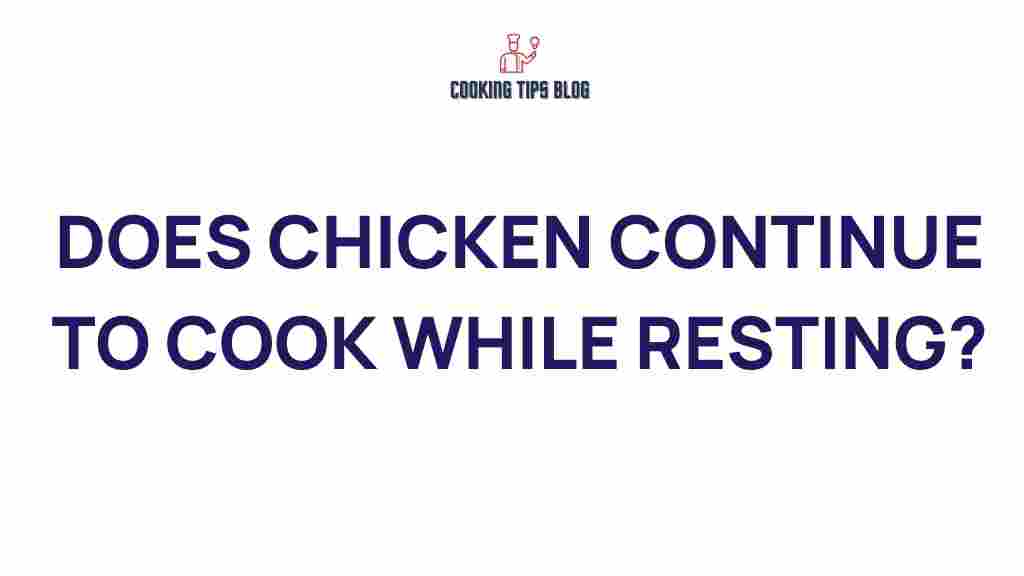Understanding the Science Behind Chicken Cooking
When it comes to cooking chicken, many home chefs are often surprised to learn that the meat continues to cook even after it has been removed from the heat source. This phenomenon, known as residual cooking or carryover cooking, plays a significant role in ensuring perfectly cooked chicken. In this article, we will delve into the science behind why chicken continues to cook while resting, the factors that influence this process, and tips for achieving the best results in your chicken cooking endeavors.
The Basics of Chicken Cooking
Before we explore residual cooking, it’s essential to understand the basic principles of chicken cooking. The process involves applying heat to the chicken, which causes the proteins in the meat to denature and coagulate. This transformation is what ultimately makes the chicken safe to eat and gives it the desired texture.
Here’s a quick overview of the chicken cooking process:
- Heating: The application of heat breaks down the connective tissues and fat in the chicken, enhancing flavor and tenderness.
- Temperature: Cooking chicken to the correct internal temperature (165°F or 74°C) is crucial for food safety.
- Resting: Allowing the chicken to rest after cooking is equally important for texture and juiciness.
Why Does Chicken Continue to Cook After Removal from Heat?
Chicken cooking does not stop immediately once it is removed from the heat. Instead, the residual heat within the meat continues to raise its internal temperature. This is primarily due to the following factors:
- Residual Heat: The heat retained in the meat continues to circulate, causing the temperature to rise for a short period.
- Thermal Conductivity: Chicken is a good conductor of heat, which allows heat to move from the exterior to the interior of the meat.
- Moisture Content: Moisture in the chicken can also aid in heat transfer, contributing to the continued cooking process.
The Importance of Carryover Cooking
Understanding carryover cooking is vital for achieving optimal results in chicken cooking. Here’s why:
- Prevents Overcooking: By accounting for carryover cooking, you can remove the chicken from heat just before it reaches the desired temperature.
- Enhances Juiciness: Allowing chicken to rest helps redistribute the juices throughout the meat, resulting in a more succulent dish.
- Improves Flavor: Resting allows the flavors to meld, providing a richer taste experience.
Step-by-Step Process of Cooking Chicken
To maximize the benefits of carryover cooking, follow these steps:
Step 1: Prepare the Chicken
Start by selecting high-quality chicken, whether it’s whole, breasts, thighs, or drumsticks. Rinse the chicken under cold water and pat it dry with paper towels. Season it generously with salt, pepper, and any other herbs or spices you prefer.
Step 2: Choose the Right Cooking Method
Chicken can be cooked using various methods, including:
- Grilling: Adds a smoky flavor and creates a crispy exterior.
- Roasting: Ideal for whole chickens, ensuring even cooking.
- Poaching: Keeps the chicken moist and tender.
- Sautéing: Quick and effective for chicken pieces.
Step 3: Monitor the Temperature
Use a meat thermometer to monitor the internal temperature of the chicken. Remove the chicken from heat when it reaches about 160°F (71°C), as the temperature will continue to rise during resting.
Step 4: Let It Rest
Once removed from heat, cover the chicken loosely with aluminum foil and let it rest for 5 to 15 minutes. This resting period allows carryover cooking to occur and enhances the juiciness.
Step 5: Carve and Serve
After resting, carve the chicken against the grain and serve with your favorite sides. Enjoy the perfectly cooked chicken that benefits from the science behind residual heat!
Troubleshooting Common Issues in Chicken Cooking
Even with a solid understanding of chicken cooking, issues can arise. Here are some common problems and their solutions:
Issue 1: Dry Chicken
Solution: Monitor the internal temperature closely and remove the chicken from heat just before it reaches the target temperature. Resting is essential to help retain moisture.
Issue 2: Undercooked Chicken
Solution: Use a meat thermometer to ensure the chicken reaches the safe minimum internal temperature of 165°F (74°C). If it’s undercooked, return it to the heat until fully cooked.
Issue 3: Uneven Cooking
Solution: Ensure uniform thickness in chicken pieces, which promotes even cooking. Consider using a meat mallet to flatten thicker areas.
Issue 4: Lack of Flavor
Solution: Season generously before cooking and consider marinating for a few hours to infuse flavor. Resting also helps enhance the taste, as the juices redistribute.
Conclusion
Understanding the science behind chicken cooking, particularly the effect of residual heat, can significantly enhance your culinary results. By mastering the art of carryover cooking, you can ensure your chicken is juicy, flavorful, and safe to eat. Remember to monitor temperature, allow for resting, and troubleshoot common issues to elevate your chicken cooking skills.
For more tips on perfecting your chicken cooking techniques, be sure to visit our cooking guide. Additionally, for in-depth information on culinary science, consider exploring resources like the USDA Food Safety and Inspection Service.
This article is in the category Tools and created by Cookingtipsblog Team
